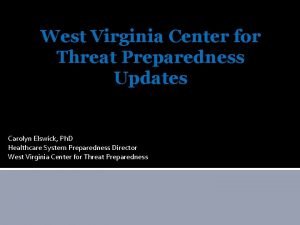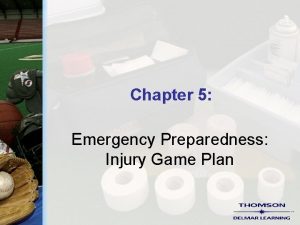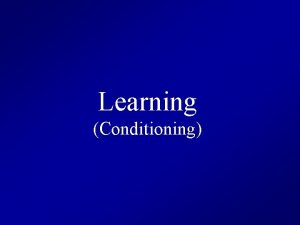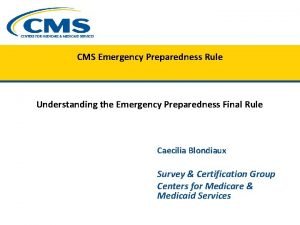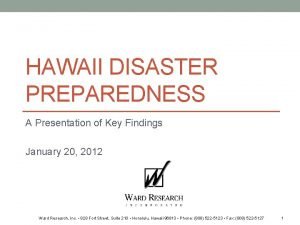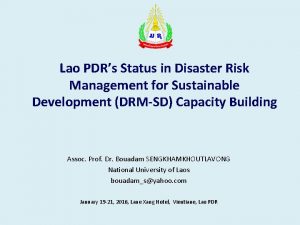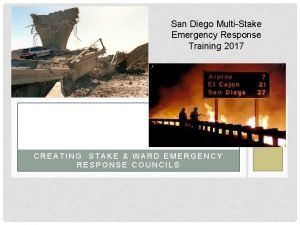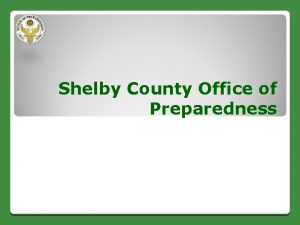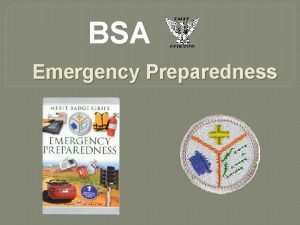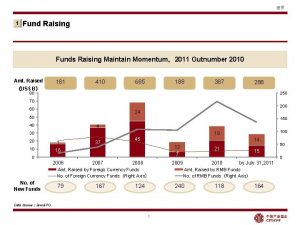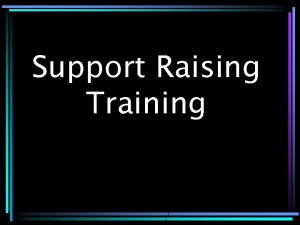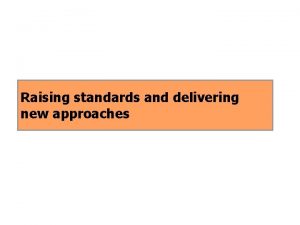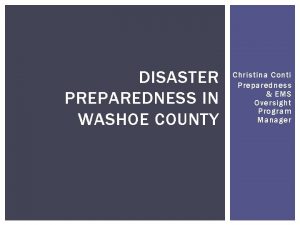Raising the Level of Preparedness for the Challenges






































- Slides: 38

Raising the Level of Preparedness for the Challenges Posed by Disasters as Priority Development Agenda for LGUs. June 4, 2014. PCL NEO-NB / CLLEP. Cebu City. Atty. Carlo Pontico C. Fortuna Volunteer, Roman Catholic Archdiocese of Palo Pastoral Disaster Response Center (RCAP-DREC)

What are Disasters? Disasters are devastating natural, accidental, or willful events that suddenly result in severe negative economic and social consequences for the populations they affect, often including physical injury, loss of life, property damage and loss, physical and emotional hardship, destruction of physical infrastructure, and failure of administrative and operational systems. The event is more than our capacity to manage.

What are Disasters? Hence, Emergency managers and responders are responsible for intervening before and during such events, to minimize the harm disasters cause and to restore order. The large scale, high complexity, profound urgency, and intense scrutiny that attend disasters provide a powerful motivation for responders to be good at response. (Amy Donahue and Robert Tuohy. Lessons We Don't Learn: A Study of the Lessons of Disasters, Why We Repeat Them, and How We Can Learn Them. (Homeland Security Affairs. The Journal of the Naval Post-Graduate School for Homeland Defense and Security )

Dynamics of Disaster: Super storm / mega-earthquake + inadequate preparation = massive destruction - > -> -> failure of the first responders -> pouring of international aid / donors -> weak / lack of an internal disaster response / management structure -> cooperation of Govt. – Church – Private Sectors

Phases in Disaster Management: RESPONSE REHABILITATION MITIGATION PREPAREDNESS

A. RESPONSE. Emergency Rescue Relief goods First aid Evacuation Set up & Activate a Helpline Set up & Activate RNA Teams (Response Needs Assessment) Determine Alternative Channel of Aid Distribution Road Clearing and Body Recovery Activation of Rescue Teams Do headcount to determine missing persons and fatalities Damage Assessment Security of Premises (i. e. looting and assaults) Evacuation Sites ◦

RESPONSE. Organized Camp management Shelter WASH kits (Water, Sanitation, & Health) Health and Nutrition Psychosocial Activate INFO COM Teams Relief Operations (purchasing / inventory of logistics Debris Removal (tap victims. Cash for work) Transitional Volunteers Needs Assessment and Targeted Response Transitional Structures i. e. command posts / relief centers / tent cities

RESPONSE. Organized Targeted Populations: Isolated Communities Vulnerable Sectors: Pregnant women Senior citizens Lactating mothers Orphaned children Persons with Disabilities Special Children

B. REHABILITATION ◦ Restore Services (ex. Utilities, govt. operations) ◦ Permanent Shelter ◦ Livelihood programs (cash for work. Cleaning/clearing/boat construction) ◦ Social Systems (back to regular masses, market activities, opening of schools, etc. ) Research Publication and Media Relations Fund Raising and Resource Generation Rehabilitation of the natural environment Recruitment / Employment of Skilled volunteers (carpenters, masons, construction workers, etc. ) Government workers should also be part of the volunteers Resumption of classes and government offices Relocation & Housing projects

C. MITIGATION ◦ Adaptation strategies (i. e. house, bldg. schools designs to be typhoon – earthquake proof) ◦ Land use policies (coastal settlements i. e. Bgy San Jose, TAC; river settlement i. e. CDO – Sendong) ◦ Construction laws (i. e. legislative remedial measures) ◦ Lifestyle changes (i. e. alternative livelihood and settlement)

C. MITIGATION Documentation of Best Practices (i. e. One Bohol; Oplan TABANG-ASAC Davao Initiatives) Form a Community of Donors Land Use Policy (no rebuilding in coastal areas or in fault lines. Hospitals should be built in low risk areas) Disaster Awareness and Training Seminars Planning for the Next Super typhoon or earthquake Renovation of Government and public infrastructures

C. MITIGATION Designing Earthquake proof / Typhoon resilient structures (i. e. INC Churches, Japanese built public classrooms in 1990 after Super Typhoon Ruping, houses in Ivatan, Batanes, government buildings i. e. pre – and post – war structures vs. 80 s onwards government edifices)

C. MITIGATION. 8 Features of a Typhoon-Proof House 1. Highly replicable "It was very simple in design and very easy to do. In two weeks' time, you can already have 6 units. " 2. Uses durable materials "You should use materials that can withstand the water and the wind. Concrete is the most logical for permanence and for strength, " Coscolluela said. Concrete is also highly abundant in the Philippines, a country with lots of sand volcanic ash– ingredients for the building material.

C. MITIGATION. 8 Features of a Typhoon-Proof House 3. 4 -side slope roofs "Quatro aguas" is a Spanish architectural term meaning a roof with 4 sides instead of just the two -sided A-frame design. QUATRO AGUAS. Four-sides roofs or hip roofs are less likely to get lifted off by strong winds.

C. MITIGATION. 8 Features of a Typhoon-Proof House 3. 4 -side slope roofs A 4 -sided roof is more typhoon-resistant because it gives wind less traction to pry the roof away. A 4 -sided roof is more streamlined and sealed against buffeting winds. Eaves should no longer be a feature of typhoonresistant homes. Eaves, which are the edges of a roof which jut out beyond the walls of the house, only give the wind more surface with which it can lift the entire roof. Slab roofs made of concrete can also be effective. Homes with roof-decks survived the storm.

C. MITIGATION. 8 Features of a Typhoon-Proof House 3. 4 -side slope roofs

C. MITIGATION. 8 Features of a Typhoon-Proof House 4. Stilts The riverside-dwelling Badjaos built their houses on stilts because of the possibility of flooding, Royal Pineda of Budji+Royal architecture firm said. This can serve as a basis for flood-resistant and storm surge-resistant homes. They can be built on legs. Even if the elevation is not that high, the force of rushing water will be lessened when it is allowed to go under the house and not just around it.

C. MITIGATION. 8 Features of a Typhoon-Proof House 5. Tempered glass with protective sticker When glass is tempered, it falls in tiny pieces like "monggo seeds, " pieces too small to cause serious injury. But combine the tiny glass bits with 300 -kilometer -per-hour winds and you're talking of another matter entirely. That's why Pineda recommends adding a protective film or sticker over tempered glass. This would keep the glass in place even when shattered by high-velocity winds. The best case scenario would be tempered glass that is also laminated but this can be pricey.

C. MITIGATION. 8 Features of a Typhoon-Proof House 6. Storm shutters Pineda recommends installing storm shutters over windows and doors, thus effectively sealing the house from winds and rain. 7. Safe, elevated location Coastal communities should be moved further away from the shoreline to lessen the risk of storm surges (flooding due to abnormal sea level rise). The vacated shoreline can then be converted into a public park, a place of leisure that won't be a big loss in case of a storm surge.

C. MITIGATION. 8 Features of a Typhoon-Proof House Storm shutters

C. MITIGATION. 8 Features of a Typhoon-Proof House 8. Revise building standards The Philippine Building Code must be updated to keep up with storms that are getting stronger, the architects agreed. The Code requires that walls of buildings should withstand at least 250 kph winds. Because Yolanda's winds went over 300 kph, this item must be revisited. Also, the practice of building drainage systems to last for "x" amount of rainfall should be changed since rain and typhoons are becoming more frequent. – Rappler. com

C. MITIGATION. Dep-Ed’s 2014 Calamity Proof classrooms feature Earthquake-resilient: bigger footing or base and thicker beams and columns. It requires a tie beam even for a single-story school. The horizontal beam connects several columns to make the structure stable. Typhoon-resilient: a combination of steel truss roofing, roof framing support that uses J-bolts, thicker roofing sheets and ridge roll, thicker and more reinforcing bars or rebars for roof beams, and a drop ceiling. (Yahoo news) Challenge: Monitoring to ensure compliance by contractors.

C. MITIGATION. Dep-Ed’s 2014 Calamity Proof classrooms feature

D. PREPAREDNESS ◦ Hazard maps (geo hazards. Earthquake prone, landslide, flood prone areas, etc. ) ◦ Evacuation routes (i. e. evac route for tsunami warnings) ◦ Disaster Training ◦ Survival Kits ◦ Drills & Exercises

D. PREPAREDNESS Publication of a Disaster Manual Adequate Calamity Fund Disaster Mapping Disaster Response Team Grassroots Disaster Response Team Disaster Preparedness and Awareness in School Curriculum

CLUSTERS Food Security Water & Sanitation Health and Hygiene Shelter Psycho-social Support Structures (info-com, camp management & finance/logistics/resource mob)

RESPONSE TRACKS Information Management Donor Relations and Aid Management Environmental Management Volunteer Management Care of Government Workers / First Responders Rehabilitation of Government Infrastructures Camp Management (evac centers and command center)

COMMON PROBLEMS Weak Planning. Example. Evacuation sites for Yolanda became sites of disaster notwithstanding information of the extent of the storm surge. Base of operations for first responders was in the path of the storm surge. Total shutdown was not anticipated or if it was, there were no contingencies. No Evac plans out of city. resource management. more than 6 months have already passed since Yolanda yet Government has not yet build permanent relocation sites nor even rehabilitated most of the schools. Evacuation. inadequate and insufficient evacuation centers (in and out of Leyte) Situational awareness. Communications. Coordination.

COMMON PROBLEMS. On Site communications systems fail command control structures are fractured resources are slow to be deployed When communications fail, the rest of the response fails Need to have contingency plans for how to communicate when technology fails or is destroyed Willingness to share information Unclear and conflicting and multiple Resources: personnel, equipment, supplies, commodities, specialized capabilities Mobilization of resources should be rapid Real Time acquisitions Resource acquisition and management are major functions of disaster management Normal resource acquisitions are too slow and are not designed to obtain large amounts of supplied rapidly.

COMMON PROBLEMS. On Site Lack of coordination of first responders Each agency has legitimate missions, responsibilities and jurisdiction, each uses its command control process to take charge in a legitimate attempt to solve the problems the agency is supposed to solve. Absent an overarching command structure to which all participants must subscribe, however, the result is duplicative and conflicting effort.

COMMON PROBLEMS. On Site Overlapping functions of certain offices resulted to confused organizational structure and response. inadequate communication between levels of government concerning specific needs lack of full awareness of supply inventories and agency capabilities (i. e air assets, body bags, relief goods, clearing equipment ex. Chainsaws, etc. )

COMMON PROBLEMS. On Site failure to have a single person in charge with a clear chain of command Unclear, multiple conflicting, uncooperative and isolated command structures Need for a robust command control structure to emerge from the chaos; Who is in charge? inability to cut through bureaucratic red tape. Difficulty in procurement as well as resource allocation.

CONCLUSION. Learning is, at its core, a process of growth; thus a successful learning process requires a commitment to change. Organizational change is notoriously difficult, but particular challenges attend change in the emergency response arena. One challenge is political traction. Individual citizens rarely see their emergency response systems in action. They generally assume the systems will work well when called upon. Moreover, citizens underestimate the likelihood that disaster will befall them. Yet citizens are confronted every day by other problems they want government to fix – failing schools, blighted communities, and high fuel prices.

CONCLUSION. Politicians tend to respond to these more immediately pressing demands, deferring investments in emergency preparedness until a major event re-awakens public concern. As one incident commander put it, “Change decisions are driven by politics and scrutiny, not rational analysis. ” High-profile events and the media attention they garner generate opportunities to make changes because public fear prompts politicians to support improvements.

CONCLUSION. As a practical matter, then, the main problem with lesson learning can be seen as a lack of will and commitment, rather than a lack of ability. If lessons learned become a priority for leaders – especially local leaders who will be called to manage disasters directly – then lessons learned have a better chance of becoming a priority for everybody. Most big lessons are inter-agency lessons. Learning them requires learning within and across agencies. It is not enough for agencies to try to learn these kinds of lessons in isolation. Disasters are regional – they do not recognize jurisdictional boundaries or disciplinary parochialism. Our systems for learning from disasters must therefore span these barriers.

CONCLUSION. The very real consequence of failing to learn lessons is loss of lives and property. In short, as one responder told us: “If we don’t learn these lessons, people are going to die again, because we failed to fix the problems that killed people the last time. ” We should not belittle the magnitude of this challenge, however; problems recur because they are inherently very difficult to solve. If solutions were evident, emergency response professionals would have adopted them long ago. This should motivate agencies in all emergency response disciplines and at all levels of government to give serious attention to the goal of inculcating a culture of learning from past disasters to prevent future losses. (Amy Donahue and Robert Tuohy. Lessons We Don't Learn: A Study of the Lessons of Disasters, Why We Repeat Them, and How We Can Learn Them. (Homeland Security Affairs. The Journal of the Naval Post-Graduate School for Homeland Defense and Security)

Resources. Additional Resources: http: //www. hsaj. org/? fullarticle=2. 2. 4 ( Homeland Security Affairs) & http: //nidm. gov. in/PDF/safety/flood/link 2. p df (Cyclone Resistant Building Architecture by UNDP Disaster Risk Management Program) - Roman Catholic Archdiocese of Palo Pastoral Disaster Response Center

THANK YOU
 Biological preparedness
Biological preparedness Skinner box
Skinner box Emap
Emap West virginia center for threat preparedness
West virginia center for threat preparedness Biological preparedness
Biological preparedness Nfpa 1600
Nfpa 1600 Chapter 5 emergency preparedness injury game plan
Chapter 5 emergency preparedness injury game plan Biological preparedness
Biological preparedness Cms emergency preparedness final rule
Cms emergency preparedness final rule Chapter 36 emergency preparedness and protective practices
Chapter 36 emergency preparedness and protective practices National radiological emergency preparedness conference
National radiological emergency preparedness conference Do. 27 s. 2015 promoting family earthquake preparedness
Do. 27 s. 2015 promoting family earthquake preparedness Hawaii disaster preparedness
Hawaii disaster preparedness Dog bite pictures
Dog bite pictures Chapter 36 emergency preparedness and protective practices
Chapter 36 emergency preparedness and protective practices Conclusion for disaster management
Conclusion for disaster management Stake emergency preparedness plan
Stake emergency preparedness plan Hotel cyber security
Hotel cyber security What is the role of government in disaster management
What is the role of government in disaster management Shelby county office of preparedness
Shelby county office of preparedness Bsa emergency preparedness
Bsa emergency preparedness Preparedness mitigation response recovery
Preparedness mitigation response recovery Pip framework
Pip framework Raising a godly child in an ungodly world
Raising a godly child in an ungodly world Prayer is the raising of the heart and mind to god
Prayer is the raising of the heart and mind to god Nadar raising photography to the height of art
Nadar raising photography to the height of art John 11:38-40
John 11:38-40 Subtree raising
Subtree raising A ladder belt or a leg lock should be used when
A ladder belt or a leg lock should be used when Describe preindustrial societies of horticulturalists
Describe preindustrial societies of horticulturalists Dr lauren vargas
Dr lauren vargas Raising capital definition
Raising capital definition Thirteen equals one
Thirteen equals one Awareness raising tv spot
Awareness raising tv spot Disadvantage of raising minimum wage
Disadvantage of raising minimum wage Raising attainment
Raising attainment 12 guideposts michael shurtleff
12 guideposts michael shurtleff Tohru raising the floor
Tohru raising the floor Monophasic liquid for application to skin or mucus membrane
Monophasic liquid for application to skin or mucus membrane



